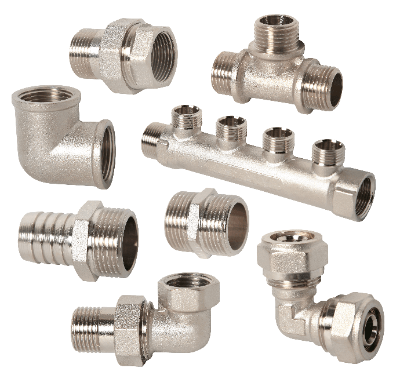What Is a Pipe Fitting?

A pipe fitting is a component used to connect different types of pipes.
It is one of the main methods of connecting pipes, but it also serves not only to extend pipes but also to change the direction of routes, branch or join pipes, enlarge or reduce the diameter of pipes, and seal the ends of pipes. Some pipe fittings are removable after connection, while others are not. In terms of ease of maintenance, it is recommended that removable pipe fittings be used for part of the piping.
It is very convenient to use both types of fittings, because while fixing the entire pipe increases its strength, doing so makes it impossible to replace only the faulty part. There are also various shapes, materials, and connection methods. It is necessary to select the appropriate pipe fitting according to the application of the fitting and the type and material of the piping.
Uses of Pipe Fittings
A pipe fitting is a component that connects pipes that transport gases and liquids. Therefore, a pipe fitting is used in facilities that use piping.
Specifically, they are used in water supply facilities, hot water supply facilities, drainage pipes, ventilation pipes, gas piping, fire prevention piping, cold and hot water circulation systems for air conditioning, agricultural water piping, chemical plant piping, and hydraulic piping. In addition to fluid piping, pipe fittings are also used for cable protection in the electric power and telecommunications fields, and are expected to improve construction work efficiency in the future as the use of utility poles is promoted.
Principle of Pipe Fittings
A pipe fitting is generally connected in two ways: flanged and screwed.
1. Flange Method
In the flange method, pipes are connected using a flange, which is a ring of two planes fixed to each other with a fitting in between. Since the fittings are secured to each other via the flanges and tightened with bolts, this method is characterized by high durability.
2. Screw-in Method
The screw-in method connects pipes by making a cut at the end of the pipe, creating a spiral groove in the groove, and cutting a spiral groove that matches the end of the pipe to be connected. This method is simpler than the flange method and is used for relatively small pipes.
Types of Pipe Fittings
A pipe fitting has a wide variety of shapes and connection methods due to its extremely wide range of applications. In many cases, products from different manufacturers can be connected to each other, but it is important to check for compatibility before use.
The main types of Pipe Fitting are as follows:
- Socket
Sockets are used to connect straight pipes of the same diameter with the same external threads. - Nipple
Connects straight pipes of the same diameter with the same internal thread. - Coupling
Directly connects straight pipes of the same diameter without threading. - Elbow
Used to bend the direction of piping. Bending angles include 45°, 90°, and 180°. - Bend
Used to bend the direction of piping. Compared to elbows, bends have a larger radius of curvature. - Reducer
Used to connect straight pipes of different diameters. - Cheese
Pipe Fitting with a T-shape to branch a pipe into a T-shape. - Cross
Pipe Fitting in the shape of a cross, which branches a pipe in four directions. - Cap
A cap is connected to a pipe by placing it over the pipe or by connecting it to the outer thread of the pipe to seal the end of the pipe. - Plug
A plug is connected to a pipe by fitting it into the pipe or connecting it to the inner thread of the pipe and sealing the end of the pipe.
Other Information on Pipe Fittings
1. How to Connect Pipe Fittings
Pipe fitting connection methods include threaded, welded, and flanged.
Threaded type
The pipe fitting is threaded, and the piping person threads it out for use. Since this connection method is removable, it is easy to repair and maintain.
Welded Type
The pipe fitting is inserted into the pipe and welded by insertion welding, or butt-welded by butt-welding the ends of the pipe and fitting against each other. This type of welding is stronger and more reliable than the screwed-in type.
Flange Type
Pipe flanges are connected with a bottle and nut.
Shafting Type
The pipe fitting is inserted into the pipe and welded by insertion is connected by wedging the sleeve of the pipe fitting into the pipe. When using a pipe fitting, the appropriate pipe fitting should be selected based on the shape, connection method, material, and size (pipe diameter) as described above.
2. Threaded Sealing Material
When using a screw-in pipe fitting, a sealing material is required. Sealant prevents leakage from the joint. There are two types of sealing materials: liquid type and tape type.
In the case of screws, even when fastened, a gap exists between the outer and inner threads. The role of the sealant is to fill the gap at the screw.